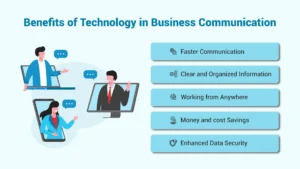When the pandemic started, we thought it was temporary, so employees were using their personal cell phones to keep in touch with clients and co-workers.
But as it became more long-term, many companies realized they needed the features of the business phone system. Companies who were already using VoIP systems could tell their employees to take their desk phone home, plug it into the Internet and they got all the features of being in the office.
What is a Softphone?
This past week, I got to explore an option of a VoIP phone system known as a “softphone”. A softphone is software that allows users to make calls via the computer or a smartphone.
It has all the features of a desk phone without taking up space on your desk or keeping you tied to a desk. It allows you to take your work phone wherever you go while allowing your employees more flexibility in the way they communicate with each other and with clients.
Softphone vs Traditional Desk Phone:
| Feature | Softphone | Desk/Hard Phone |
| Hardware | Runs on existing devices | Requires dedicated hardware |
| Mobility | Works anywhere with internet | Fixed location |
| Setup | Quick, digital configuration | Physical wiring needed |
| Cost | Low (no hardware) | Higher (hardware + maintenance) |
| Integration | Connects with CRM, helpdesk, chat tools | Limited |

How Does a Softphone Work?
The best softphone software is used to mimic the functionality of a desk phone using your desktop, laptop, or smartphone.
The software is compatible with all operating system software. It uses something called Session Initiation Protocol (SIP) as part of Voice over Internet Protocol (VoIP) technology. The SIP is used to dial numbers, see if someone is available, conference in 2nd caller, and other features associated with typical phone systems.
VoIP allows voice to be converted to send it over the internet. This software will even allow video calling, messaging, and presence features, using technology called Extensible Messaging and Presence Protocol (XMPP).
What are the Benefits of Using a Softphone?
Adopting a softphone system offers significant operational and financial advantages:
1. Cost Savings
You eliminate hardware, maintenance, and long-distance call charges. All you need is an internet connection and a headset.
2. Flexibility & Mobility
Work from home, the office, or even while traveling — your phone number travels with you.
3. Scalability
Add or remove users instantly without extra hardware. Perfect for growing teams or seasonal businesses.
4. Unified Communications
Integrate voice, video, chat, and CRM into a single interface, streamlining workflows.
5. Better Collaboration
Team members can share files, chat in real-time, and join instant calls, improving productivity across departments.
6. Reporting & Compliance
Gain insight into call volumes, durations, and performance. Many softphones also support call encryption and compliance with GDPR or HIPAA.

Softphone Features for Efficient Team Communication and Collaboration
Modern softphones go far beyond simple voice calling. They’re built to be unified communication hubs. Common features include:
- HD Voice & Video Calling: Crystal-clear communication across teams and clients.
- Call Transfer, Hold & Multi-Line Handling: Seamlessly manage multiple calls at once.
- Voicemail & Transcription: Receive messages as text or email attachments.
- Conference Calling & Screen Sharing: Perfect for virtual meetings.
- Presence & Instant Messaging: See who’s online and chat instantly.
- Click-to-Call & CRM Integrations: Connect directly from Salesforce, HubSpot, or your helpdesk.
- Call Recording & Analytics: Ideal for compliance, training, and performance tracking.
- Multi-Device Support: Switch between desktop, laptop, or mobile without dropping a call.
Many softphones also support call encryption, auto-provisioning, and SIP trunking, which enhance security and scalability.
Limitations, Challenges & How to Mitigate Them
| Challenge | Description | Mitigation |
| Internet Dependence | Voice quality depends on bandwidth and stability. | Use QoS routers and reliable ISPs. |
| Latency / Jitter | Delay or distortion in calls. | Use modern codecs and monitor network performance. |
| Firewall & NAT Issues | Some networks block SIP traffic. | Configure STUN/TURN/ICE servers. |
| Power Outages | Softphones need powered devices and the internet. | Use mobile data or backup lines. |
| Security Risks | SIP hijacking or call interception is possible. | Enable SRTP/TLS encryption and strong authentication. |
| Compatibility | Some OS or devices may not support all features. | Check software requirements before deployment. |
Softphone vs Desk Phone / Other Systems
| Factor | Softphone | Hard Phone |
| Installation | Simple (software only) | Hardware setup |
| Cost | Low recurring | High upfront |
| Integration | CRM, chat, helpdesk | Minimal |
| Mobility | Anywhere | Fixed |
| Use Case | SMBs, remote teams | Offices |
When to use each:
- Softphone: Ideal for hybrid, remote, or mobile teams.
- Hard Phone: Suits static offices or secure environments.
- UC Platform: Best for enterprises needing full-scale collaboration tools.
Types & Examples of Softphones / Platforms
Softphones come in different forms depending on their purpose and integration level:
-
Standalone Softphones:
Tools like Bria, Zoiper, Acrobits, MicroSIP — flexible, SIP-compatible, and customizable.
-
Integrated Softphones:
Built into collaboration suites like Microsoft Teams, Zoom, Slack, RingCentral, or 3CX.
-
Provider-Based Softphones:
Offered by VoIP vendors such as Nextiva, Vonage, 8×8, or GoTo Connect as part of a service bundle.
-
Free vs Paid Software:
- Free: Basic calling and messaging.
- Paid: HD audio, advanced integrations, encryption, and business support.
Choosing Providers, System Requirements, and Setup Ease
Softphone require a service provider. There are several options, but the one we recommend here at Techno Advantage is called Grandstream Phone.
Additionally, a strong bandwidth or internet connection is needed. Finally, a microphone, speakers, headset, or smartphone is needed.
Making changes to a softphone system is easier than traditional desktop phones, as no new lines need to be installed or extensions provided, and the new line is automatically added to all existing contacts.
All changes can be made via the cloud server with the right login credentials, and no technical team is needed.
How to Set Up / Deploy a Softphone (Step-by-Step)
-
Check Requirements:
Stable internet (at least 100 kbps per call), quality headset, and compatible OS.
-
Install Software or App:
Download from the vendor’s site or app store.
-
Enter SIP Credentials:
Your VoIP provider supplies username, password, and server details.
-
Configure Codecs:
Use optimized codecs (G.729 or Opus) for best quality.
-
Test Calls:
Make internal and external test calls; monitor latency and clarity.
-
Apply Best Practices:
- Enable QoS on routers
- Whitelist SIP ports in firewall
- Use VPNs for remote workers
- Monitor call analytics for ongoing improvements
FAQ — Common Questions About Softphones
Q: Is a softphone the same as VoIP?
Not exactly. VoIP is the technology, while a softphone is the software interface that uses it.
Q: Can a softphone work without the internet?
No. It relies on a stable internet connection to function.
Q: What operating systems support softphones?
Windows, macOS, Android, iOS, and Linux — depending on the vendor.
Q: Can softphones integrate with CRM or helpdesk tools?
Yes. Many offer native integrations with Salesforce, HubSpot, Zendesk, and more.
Q: Are Microsoft Teams or Zoom considered softphones?
Yes, partially. They use softphone functionality as part of their UCaaS suite.
Q: What happens during an internet outage?
Calls are typically redirected to voicemail or a backup mobile line.
Q: Are softphones secure?
When configured with TLS/SRTP encryption and proper authentication, they’re as secure as enterprise-grade communication systems.
Conclusion
A softphone system is definitely a great way to boost your business’s productivity. By incorporating the benefits of a traditional desk phone with the tools of a modern workplace softphone provides a solution that provides flexibility in how you communicate with clients and coworkers.
Decreasing reliance on a technical team to make changes to your phone system, and the ability to make those changes from anywhere is a definite plus.
Take your business communication with a softphone system.
Author
-
Jay S. Allen, MCP, MCSA, MCSE, MCSE+ Security, is an experienced IT professional with more than 20 years in the industry. He specializes in delivering enterprise-level cybersecurity and IT support solutions tailored to small and mid-sized businesses. Through Techno Advantage, Jay is dedicated to helping organizations strengthen their security posture and achieve greater efficiency through smart, scalable technology solutions.












